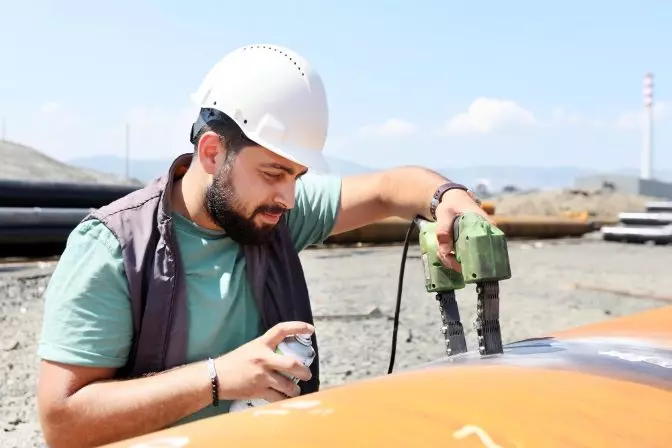Nickel Based Alloy Welding Electrodes Nickel Based Alloy Welding Electrodes,Nickel-Based Alloy Welding Rod,Nickel Based Alloy Welding Rod,Nickel Based Alloy Welding Electrode JIANGSU FUERMU WELDING CORPORATION , https://www.fuermuwelding.com
# Magnetic Particle Inspections: A Comprehensive Guide
Magnetic particle inspection is a widely utilized method for identifying surface defects in ferromagnetic materials. By applying a magnetic current, inspectors can pinpoint issues such as cracks, pores, and welding inconsistencies like cold lap and lack of sidewall fusion.
This technique is also known as magnetic particle testing (MT), magnetic testing, or simply particle inspection. Throughout this guide, we'll refer to it interchangeably as magnetic particle inspection or testing, adhering to its various aliases.

The fundamental principle involves magnetizing the material under inspection. If no defects exist, the magnetic field flows uniformly through the material. However, when defects occur, they disrupt the field, creating a secondary flux leakage field that attracts magnetic particles. These particles cluster around the defect, making it visible to inspectors.
Magnetic particle testing is favored for its speed and cost-effectiveness, yet it's limited to ferromagnetic materials such as steel, cobalt, iron, and nickel. It’s just one of many non-destructive testing methods, each with its own advantages and applications.
## Understanding Magnetic Particle Testing
To perform an MPI, inspectors begin by magnetizing the material. Defects, if present, interrupt the magnetic field, creating a secondary flux leakage field. Next, magnetic particles are spread across the surface—either as a powder or suspended in liquid. These particles are attracted to the leakage field, highlighting the defect.
The particles are often dyed black or coated with fluorescent pigments to enhance visibility. Inspectors choose between dry and wet methods depending on the environment and the type of defect they aim to detect.
## The Evolution of Magnetic Particle Testing
The origins of magnetic particle testing date back to 1868 when it was first used to examine cannon barrels. By magnetizing the barrel and following its length with a magnetic compass, any disruptions in the magnetic field indicated potential flaws.
In the 1920s, inventor William Hoke discovered that metallic shavings could trace defect locations on magnetized ferromagnetic surfaces. His discovery laid the groundwork for modern MPI techniques. By the 1930s, the railroad industry had adopted this method, marking the beginning of its widespread application.
Today, the core principles remain unchanged, though technology has advanced to include more sophisticated equipment and techniques.
## The Advantages and Challenges of Magnetic Particle Testing
While magnetic particle testing offers numerous benefits, it also presents certain limitations.
### Benefits:
- **Rapid and Cost-Effective**: Quick to implement with minimal expense.
- **Immediate Results**: Visible defects appear directly on the surface.
- **Minimal Cleaning Required**: No strict cleaning regimen needed before or after testing.
- **Highly Sensitive**: Detects fine surface cracks effectively.
- **Versatile**: Suitable for oddly shaped objects and surfaces with additional coatings.
- **User-Friendly**: Requires little training to operate.
### Drawbacks:
- **Material Restriction**: Only ferromagnetic materials can be tested.
- **Depth Limitation**: Primarily detects surface and subsurface defects up to 0.100 inches deep.
- **Post-Test Demagnetization**: Necessary but can be challenging.
- **Alignment Requirements**: Must align the indication with the magnetic flux.
- **Limited Scope**: Can only examine small areas at a time.
- **Surface Coatings**: Paint thicker than 0.005 inches must be removed.
## Techniques in Magnetic Particle Testing
Inspectors employ either dry magnetic particle testing (DMPT) or wet magnetic particle testing (WMPT). Both methods involve spreading magnetic particles on the surface, but the medium differs—powder for DMPT and liquid suspension for WMPT. Inspectors may opt for fluorescent or non-fluorescent particles based on environmental conditions.
### Two-Step Process:
1. **Magnetize the Object**: Pass a magnetic current through the material to create a flux leakage field if defects are present.
2. **Apply Magnetic Particles**: Spread particles over the surface, which gather at defect locations, revealing their presence.
While the process is simple, careful consideration goes into how magnetization is achieved and maintained.
## Magnetization Considerations
Inspectors have several options for magnetizing materials during an MPI:
- **Longitudinal Magnetization**: Aligns the magnetic field parallel to the defect.
- **Multidirectional Magnetization**: Applies multiple magnetic fields simultaneously.
- **Yoke Technique**: Uses an electromagnet to create a magnetic field.
- **Prod Technique**: Utilizes direct contact with the material.
- **Circular Magnetization**: Creates a circular magnetic field around the object.
The magnetic field should ideally be perpendicular to the defect for optimal detection. Therefore, inspectors often perform two inspections—one in each orthogonal direction.
## Essential Magnetic Particle Testing Equipment
A variety of specialized equipment supports magnetic particle testing:
- **Magnetic Wet Benches**: Generate circular and longitudinal magnetic fields.
- **Power Packs/Generators**: Provide adjustable magnetic currents.
- **Magnetic Yokes**: Create localized magnetic fields.
- **Enclosures/Hoods/Curtains**: Darken the testing area for better visibility.
- **Demagnetizers**: Remove residual magnetism after testing.
## Standards and Regulations
Certain inspections require adherence to international standards, with certifications necessary for inspectors. Key standards include ASTM, ISO, and CEN guidelines, ensuring consistency and reliability in magnetic particle testing practices.
In conclusion, magnetic particle inspection remains a vital tool in non-destructive testing, offering unique advantages despite its limitations. Its versatility and cost-effectiveness continue to make it a preferred choice across industries.
---
By understanding these principles and techniques, inspectors can leverage magnetic particle testing to ensure the integrity of critical components, safeguarding both quality and safety.